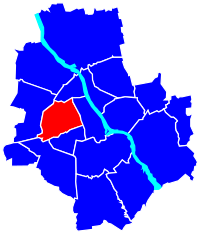Wola (Warsaw)
|
Wola (Warsaw) district of Warsaw |
|
|---|---|
| Coordinates | 52 ° 14 '0 " N , 20 ° 57' 26" E |
| surface | 19.26 km² |
| Residents | 143,996 (2003) |
| Population density | 7476 inhabitants / km² |
| Website | wola.waw.pl |
| License Plate | WY |
| politics | |
| mayor | Krzysztof Strzałkowski |
Wola is a district of the Polish capital Warsaw . It borders the city center to the west and lies on the left side of the Vistula . Wola is divided into eight sub-districts: Ulrychów , Koło, Odolany , Nowolipki , Mirów, Młynów, Czyste and Powązki . The common Polish place name Wola means "hamlet". But since “wola” also means “will ” in Polish and the name of a border district is Ochota (“ochota” = lust ), this creates puns among Warsaw residents .
history
Wola was a village well into the 19th century and was known for the choice of kings that were fought here.
In the last days of the Polish November Uprising of 1830/31 in the Russian Congress Poland, a bloody battle raged between the Polish defenders of the capital under General Józef Sowiński and the advancing Russian troops in what was then the westernmost outskirts of Warsaw . Most of the Poles, including the general, fell in battle.
Wola was incorporated into Warsaw during the German occupation in World War I in 1916 and has been one of the central districts in the Polish capital ever since.
Before the Second World War , Wola was a working class district with its many factories. The communists wanted to see the “red wola” in the district, a center of the labor movement in Warsaw. After 1945 some works were named after socialists such as Rosa Luxemburg , Marcin Kasprzak or Ludwik Waryński . Wola was home to numerous factories, the large Haberbusch & Schiele brewery, gas and electricity plants and the capital's first and now oldest tram depot .
During the German occupation in World War II , Wola was separated from the city center between 1939 and 1943 - in between was the Warsaw Ghetto . By means of an "Aryan" street (Chłodna Street to Plac Za erhaltenelazną Bramą ) blocked off on both sides , the direct transport connection to the city center ( Śródmieście ) was maintained. The ghetto itself was burned down by the German SS troops in May 1943 . Almost all Jewish residents were deported to the extermination camps, most of them to Treblinka .
A tragic fate met the inhabitants of Vola after the outbreak of the Warsaw Uprising on August 1, 1944. The German units advancing from the west fought their way into the city here to crush the rebels, killing over 150,000 civilians. Several thousand residents and people working here were shot in the Wola massacre in the first days of August . Thousands were deported to concentration camps. Many memorial plaques remind of this. In the former tram power station, the Warsaw Uprising Museum is now located on Przyokopowa Street and Grzybowska Street. The original, now completely rebuilt building dates from 1908 with extensions from 1920. In 2003 Wojciech Obtułowicz won the architectural competition for the redesign, the exhibition concept comes from Mirosław Nizio, Jarosław Kłaput and Dariusz Kunowski using the latest multimedia technology. A 35-meter tower is the symbol of the fighting Poland. In 2005 a museum chapel was consecrated by Józef Cardinal Glemp with the name of Józef Stanek .
present
The Za Żelazną Bramą block of flats lies in the east of the district and extends across the Johannes-Paul-II- Allee (district boundary), so that the east of the district is perceived by many as the inner city. The Church of the Birth of Mary, which was destroyed in the war , was reconstructed in the 1950s. The factory halls were partly modernized and the proximity of the city meant that many modern offices and apartment buildings are being built in the west of Vola and the district is losing its old character. The tallest office building in the country ( Warsaw Trade Tower ) is on the corner of Chłodna Street .
The museum of industry in the former Norblin works is a reminder of the old days.
See also
- The transshipment point was the place at the Warsaw Ghetto (freight yard of Danziger Bhf.) Where the deportation trains to the Treblinka extermination camp began.
- The ghetto must not be confused with the Warsaw concentration camp .
Web links
- Wola - official website (Polish, English)
- Warsaw Uprising Museum (English; in German only opening times etc.)





